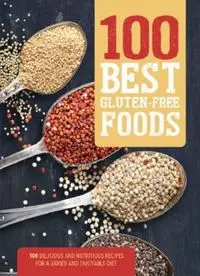
100 best gluten-free : your guide to gluten-free eating including 100 delicious recipes PDF
Preview 100 best gluten-free : your guide to gluten-free eating including 100 delicious recipes
This digital edition first published by Parragon Books Ltd in 2014 and distributed by Parragon Inc. 440 Park Avenue South, 13th Floor New York, NY 10016 www.parragon.com/lovefood LOVE FOOD is an imprint of Parragon Books Ltd Copyright © Parragon Books Ltd 2014 LOVE FOOD and the accompanying heart device is a registered trademark of Parragon Books Ltd in the USA, the UK, Australia, India, and the EU. All rights reserved. No part of this publication may be reproduced, stored in a retrieval system, or transmitted, in any form or by any means, electric, mechanical, photocopying, recording, or otherwise, without the prior permission of the copyright holder. 10 9 8 7 6 5 4 3 2 ISBN 978-1-4723-8478-2 Created and produced by made-to-measure-books New photography by Clive Streeter Nutritional consultant: Judith Wills Nutritional data obtained from the USDA national nutrient database. Notes for the Reader This book uses standard kitchen measuring spoons and cups. All spoon and cup measurements are level unless otherwise indicated. Unless otherwise stated, milk is assumed to be whole, eggs are large, individual vegetables are medium, and pepper is freshly ground black pepper. Unless otherwise stated, all root vegetables should be peeled prior to using. Garnishes, decorations, and serving suggestions are all optional and not necessarily included in the recipe ingredients or method. The times given are only an approximate guide. Preparation times differ according to the techniques used by different people and the cooking times may also vary from those given. Optional ingredients, variations, or serving suggestions have not been included in the time calculations. While the author has made all reasonable efforts to ensure that the information contained in this book is accurate and up to date at the time of publication, anyone reading this book should note the following important points: Medical and pharmaceutical knowledge is constantly changing and the author and the publisher cannot and do not guarantee the accuracy or appropriateness of the contents of this book. In any event, this book is not intended to be, and should not be relied upon, as a substitute for appropriate, tailored professional advice. Both the author and the publisher strongly recommend that a healthcare practitioner is consulted before making major dietary changes. For the reasons set out above, and to the fullest extent permitted by law, the author and publisher: (i) cannot and do not accept any legal duty of care or responsibility in relation to the accuracy or appropriateness of the contents of this book, even where expressed as “advice” or using other words to this effect; and (ii) disclaim any liability, loss, damage, or risk that may be claimed or incurred as a consequence—directly or indirectly—of the use and/or application of any of the contents of this book. CONTENTS Introduction Glossary 1 Grains and flours 2 Legumes 3 Nuts and seeds 4 Fruits 5 Vegetables 6 Meat, fish, and dairy Index INTRODUCTION Celiac disease—an autoimmune disease that causes the body to produce antibodies to react to gluten—affects around 1 in 100 people throughout the world. The only cure is to avoid gluten completely. For life. Gluten is one of the proteins found in wheat, barley, and rye, and it is also in many processed foods, but, thankfully, there is no need to feel deprived when you are on a gluten-free diet. With a little know-how, you can have a varied, nutritionally balanced, and enjoyable diet. Celiac disease damages the small Intestine and can result in unpleasant symptoms, such as nausea, bloating/gas, diarrhea, and constipation, which can be debilitating. The resulting damage to the intestine causes malabsorption of nutrients, leading to other symptoms, such as tiredness, headaches, canker sores, hair loss, anemia, osteoporosis, and weight loss, so it is important that it is properly diagnosed. Anyone recently diagnosed with celiac disease needs as nutritious and beneficial a diet as possible, because they may have been experiencing poor nutrient absorption for some time. Some people who don’t have celiac disease also follow a gluten-free diet, and the number of those who want to cut gluten from their diet is increasing. These people may experience bloating, gas, indigestion, and irritable bowel syndrome, for example, and feel a gluten-free diet helps minimize these symptoms. Or it may be a personal choice, because they may simply feel more healthy on a gluten-free diet. As well as being in wheat, barley, and rye, gluten is also found in many processed foods that contain small amounts of these grains and their by- products. Some people are also sensitive to avenin, a protein similar to gluten found in oats. Many oats may also be contaminated with gluten because they are packaged in the same factories as wheat, barley, or rye, so most celiacs avoid oats, too. Look for oats labeled as gluten-free if you still want to include them in your diet.
